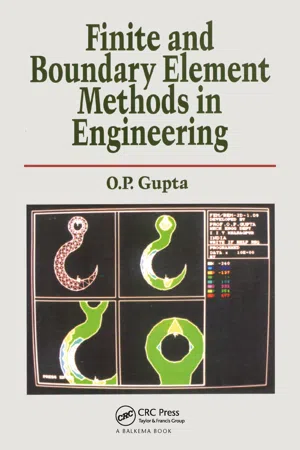
eBook - ePub
Finite and Boundary Element Methods in Engineering
O.P. Gupta
This is a test
- 494 páginas
- English
- ePUB (apto para móviles)
- Disponible en iOS y Android
eBook - ePub
Finite and Boundary Element Methods in Engineering
O.P. Gupta
Detalles del libro
Vista previa del libro
Índice
Citas
Información del libro
The interest in finite element method as a solution technique of the computer age is reflected in the availability of many general and special purpose software based on this technique. This work aims to provide a complete and detailed explanation of the basics of the application areas.
Preguntas frecuentes
¿Cómo cancelo mi suscripción?
¿Cómo descargo los libros?
Por el momento, todos nuestros libros ePub adaptables a dispositivos móviles se pueden descargar a través de la aplicación. La mayor parte de nuestros PDF también se puede descargar y ya estamos trabajando para que el resto también sea descargable. Obtén más información aquí.
¿En qué se diferencian los planes de precios?
Ambos planes te permiten acceder por completo a la biblioteca y a todas las funciones de Perlego. Las únicas diferencias son el precio y el período de suscripción: con el plan anual ahorrarás en torno a un 30 % en comparación con 12 meses de un plan mensual.
¿Qué es Perlego?
Somos un servicio de suscripción de libros de texto en línea que te permite acceder a toda una biblioteca en línea por menos de lo que cuesta un libro al mes. Con más de un millón de libros sobre más de 1000 categorías, ¡tenemos todo lo que necesitas! Obtén más información aquí.
¿Perlego ofrece la función de texto a voz?
Busca el símbolo de lectura en voz alta en tu próximo libro para ver si puedes escucharlo. La herramienta de lectura en voz alta lee el texto en voz alta por ti, resaltando el texto a medida que se lee. Puedes pausarla, acelerarla y ralentizarla. Obtén más información aquí.
¿Es Finite and Boundary Element Methods in Engineering un PDF/ePUB en línea?
Sí, puedes acceder a Finite and Boundary Element Methods in Engineering de O.P. Gupta en formato PDF o ePUB, así como a otros libros populares de Technik & Maschinenbau y Elektrotechnik & Telekommunikation. Tenemos más de un millón de libros disponibles en nuestro catálogo para que explores.
Información
Chapter 1 INTRODUCTION AND BASIC CONCEPTS
DOI: 10.1201/9780203756041-1
1.1 INTRODUCTION
The finite element method (FEM) has now become a very important tool of engineering analysis. Its versatility is reflected in its popularity among engineers and designers belonging to nearly all the engineering disciplines. Whether a civil engineer designing bridges, dams, harbours or a mechanical engineer designing auto engines, rolling mills, machine tools or an aerospace engineer interested in analysis of dynamics of an aeroplane or temperature rise in the heat shield of a space shuttle or a metallurgist concerned about the influence of a rolling operation on the microstructure of a rolled product or an electrical engineer interested in analysis of the electromagnetic field in electrical machinery—all find the finite element method quite handy and useful. It is not that these problems remained unproved before the finite element method came into vogue; rather this method has become popular due to its relative simplicity of approach and accuracy of results. Before going into detail we shall look at the limitations of the traditional approach to design and analysis and then see how neatly FEM overcomes them. The boundary element method is a sister technique inheriting many advantages of FEM.
Traditional methods of engineering analysis, while attempting to solve an engineering problem mathematically, always try for simplified formulation in order to overcome the various complexities involved in exact mathematical formulation. Here we consider some examples which illustrate the approach generally followed for solution of some engineering problems.
The behaviour of an engineering system or its components is governed by various laws of nature, such as Newton’s laws of motion for study of dynamic behaviour of moving bodies, Fourier law of heat conduction for analysis of temperature distribution in solids, Stokes’ law or the Navier-Stokes’ equation for study of motion of viscous fluids, Young’s law or various forms of force-stress-strain relationship for study of load-bearing capabilit...